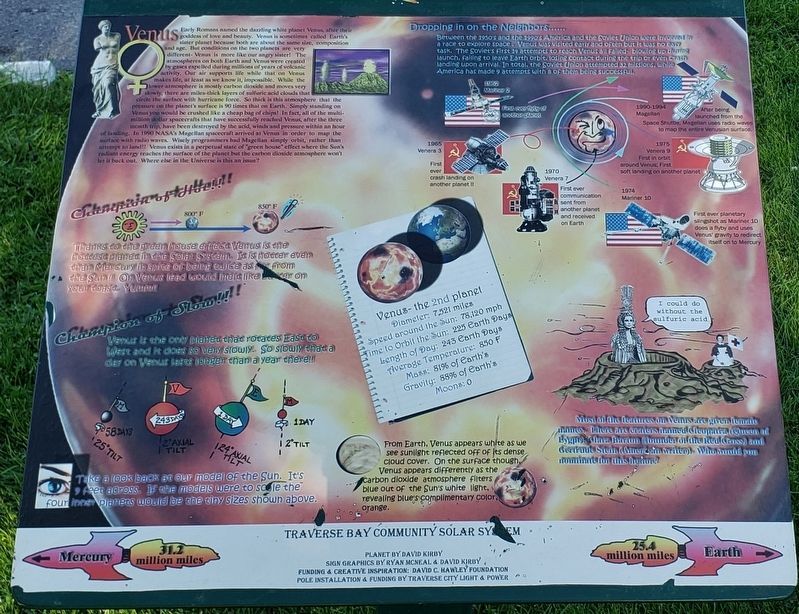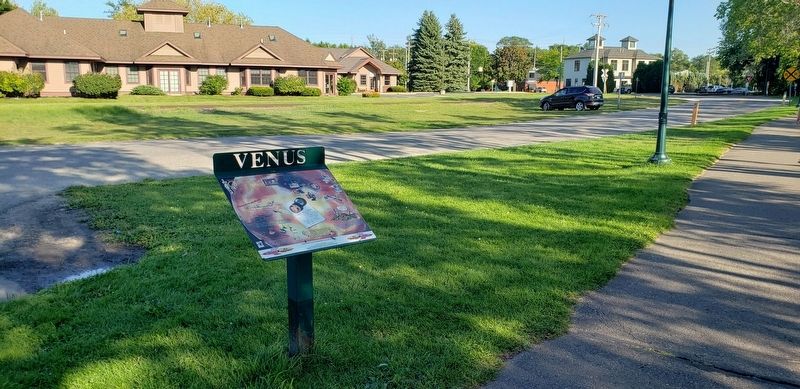Traverse City in Grand Traverse County, Michigan — The American Midwest (Great Lakes)
Venus
Early Romans named the dazzling white planet Venus, after their goddess of love and beauty. Venus is sometimes called Earth's sister planet because both are about the same size, composition and age. But conditions on the two planets are very different — Venus is more like our angry sister! The atmospheres on both Earth and Venus were created by gases expelled during millions of years of volcanic activity. Our air supports life while that on Venus makes life, at least as we know it, impossible. While the lower atmosphere is mostly carbon dioxide and moves very slowly, there are miles-thick layers of sulfuric acid clouds that circle the surface with hurricane force. So thick is this atmosphere that the pressure on the planet's surface is 90 times that on Earth. Simply standing on Venus you would be crushed like a cheap bag of chips! In fact, all of the multi-million dollar spacecrafts that have successfully reached Venus, after the three month trip, have been destroyed by the acid, winds and pressure within an hour of landing. In 1990 NASA's Magellan spacecraft arrived at Venus in order to map the surface with radio waves. Wisely programmers had Magellan simply orbit, rather than attempt to land!! Venus exists in a perpetual state of "green house" effect where the Sun's radiant energy reaches the surface of the planet but the carbon dioxide atmosphere won't let it back out. Where else in the Universe is this an issue?
Champion of Hot!!
Thanks to the green house effect Venus is the hottest planet in the Solar System. It is hotter even than Mercury in spite of being twice as far from the Sun!! On Venus lead would melt like butter on your toast. Yumm!!
Champion of Slow!!
Venus is the only planet that rotates East to West and it does so very slowly. So slowly that a day on Venus lasts longer than a year there!!
From Earth, Venus appears white as we see sunlight reflected off of its dense cloud cover. On the surface though, Venus appears differently as the carbon dioxide atmosphere filters blue out of the Sun’s white light, revealing blue’s complimentary color, orange.
Dropping in on the Neighbors…
Between the 1950’s and the 1990’s America and the Soviet Union were involved in a race to explore space. Venus was visited early and often but it was no easy task. The Soviet's first 14 attempts to reach Venus all failed — blowing up during launch, failing to leave Earth orbit, losing contact during the trip or even crash landing upon arrival. In total, the Soviet Union attempted 32 missions, while America has made 9 attempts with 8 of them being successful.
1962 • Mariner 2
First ever flyby of another planet
1965 • Venera 3
First
ever crash landing on another planet!!
1970 • Venera 7
First ever communication sent from another planet and received on Earth
1974 • Mariner 10
First ever planetary slingshot as Mariner 10 does a flyby and uses Venus’ gravity to redirect itself on to Mercury
1975 • Venera 9
First in orbit around Venus; First soft landing on another planet
1990-1994 • Magellan
After being launched from the Space Shuttle, Magellan uses radio waves to map the entire Venusian surface.
Most of the features on Venus are given female names. There are craters named Cleopatra (Queen of Egypt), Clara Barton (founder of the Red Cross) and Gertrude Stein (American writer). Who would you nominate for this honor?
Diameter: 7,521 miles
Speed around the Sun: 78,120 mph
Time to Orbit the Sun: 225 Earth Days
Length of Day: 243 Earth Days
Average Temperature: 850 F
Mass: 81% of Earth’s
Gravity: 88% of Earth’s
Moons: 0
[captions]
• I could do without the sulfuric acid
• Take a look back at our model of the Sun. It’s 9 feet across. If the models were to scale the four inner planets would be the tiny sizes shown above.
Erected by Traverse Bay Community Solar System.
Topics. This historical marker is listed in these topic lists: Air & Space • Exploration • Science & Medicine.
Location. 44° 45.36′ N, 85° 36.54′ W. Marker is in Traverse City, Michigan, in Grand Traverse County. Marker is on Hannah Avenue just west of Woodmere Avenue, on the left when traveling west. Marker is located along the Boardman Lake Trail in Hull Park. Touch for map. Marker is at or near this postal address: 660 Hannah Avenue, Traverse City MI 49686, United States of America. Touch for directions.
Other nearby markers. At least 8 other markers are within walking distance of this marker. Mother Earth (within shouting distance of this marker); Mercury (within shouting distance of this marker); Mars (about 300 feet away, measured in a direct line); Our Sun (about 400 feet away); U.S.S. Sabine Parrott Rifle (approx. half a mile away); Civil War Memorial (approx. half a mile away); Spanish-American War Memorial (approx. half a mile away); World War Memorial (approx. half a mile away). Touch for a list and map of all markers in Traverse City.
Related markers. Click here for a list of markers that are related to this marker. Traverse Bay Community Solar System
Also see . . . Why Venus Spins the Wrong Way.
(Excerpt from Scientific American, Harald Franzen, 5/15/2001) Our neighboring planet Venus is an oddball in many ways. For starters, it spins in the opposite direction from most other planets, including Earth, so that on Venus the sun rises in the west. Current theory holds that Venus initially spun in the same direction as most other planets and, in a way, still does: it simply flipped its axis 180 degrees at some point. In other words, it spins in the same direction it always has, just upside down, so that looking at it from other planets makes the spin seem backward. Now Alexandre Correira and Jacques Laskar suggest that Venus may not have flipped at all. They propose instead that its rotation slowed to a standstill and then reversed direction...(Submitted on January 3, 2023, by Cosmos Mariner of Cape Canaveral, Florida.)
Credits. This page was last revised on January 3, 2023. It was originally submitted on January 1, 2023, by Cosmos Mariner of Cape Canaveral, Florida. This page has been viewed 107 times since then and 4 times this year. Photos: 1, 2. submitted on January 1, 2023, by Cosmos Mariner of Cape Canaveral, Florida.

